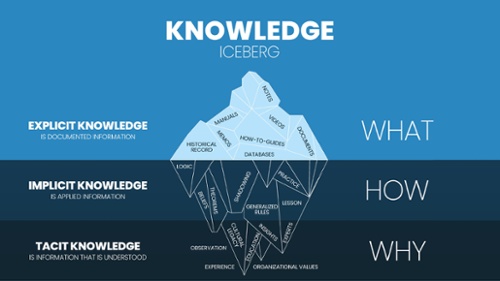Building the Business Case for AI-Ready Operations
The promise of artificial intelligence isn't just about new technologies offering efficiencies—it's about unlocking the vast reservoir of knowledge...
4 min read
![]() Innovatia Guru
:
Jul 28, 2025 1:13:09 PM
Innovatia Guru
:
Jul 28, 2025 1:13:09 PM

Organizations, including those in the industrial and energy sectors, are beginning to realize the potential of AI. Companies are witnessing transformative results: field technicians resolve complex equipment issues in minutes rather than hours, operations managers access precise maintenance procedures instantly, and organizations dramatically reduce the costly hallucinations that plague traditional AI systems.
AI systems use retrieval augmented generation (RAG) to enhance their ability to provide accurate, context-aware, and up-to-date responses. Organizations must take a conscious approach to how their knowledge bases are structured and labelled to get the most out of their AI investment.
While RAG technology brilliantly combines retrieval and generation capabilities to ground AI responses in your organization's actual knowledge base, it cannot perform miracles with poorly structured, inconsistent, or inaccessible content. The difference between a RAG system that becomes an indispensable operational tool and one that frustrates users lies squarely in the foundation of well-designed information architecture.
The Seven Pillars of Effective IA for RAG
Information Architecture (IA) for RAG goes far beyond simply having documents available for retrieval. It encompasses the strategic organization, structuring, and optimization of your knowledge assets to ensure that RAG systems can efficiently locate, extract, and synthesize the most relevant information for any given query.
The foundation of RAG-optimized information architecture begins with creating a coherent semantic structure that mirrors how your organization thinks about and categorizes knowledge. This involves developing comprehensive taxonomies that reflect your industry's terminology, equipment hierarchies, process workflows, and problem-solution relationships.
For industrial organizations, this might mean structuring content around equipment types, maintenance schedules, safety protocols, and operational procedures. Each piece of content should be tagged with relevant metadata that helps RAG systems understand not just what the information says, but what it relates to, when it applies, and how it connects to other knowledge assets.
RAG systems perform best when they can retrieve precise chunks of information rather than entire documents. This requires breaking down large documents into logically independent sections that can stand alone as coherent responses to specific queries.
Instead of storing a 200-page equipment manual as a single entity, effective IA breaks it down into independent sections: installation procedures, routine maintenance tasks, troubleshooting guides, safety warnings, and parts specifications. Each section should be comprehensive enough to answer specific questions while remaining focused enough to avoid information overload.
Rich metadata serves as the GPS for RAG retrieval. Every content element should be tagged with contextual information, including equipment models, applicable environments, required skill levels, safety classifications, regulatory requirements, and version information.
This contextual layer enables RAG systems to not only find relevant information but also understand when that information applies. A maintenance procedure tagged for "offshore environments," "Level 3 technicians," and "high-pressure systems" will only be retrieved when those specific conditions align with the user's query context.
Industrial knowledge rarely exists in isolation. Maintenance procedures are connected to safety protocols, which in turn link to regulatory requirements and reference equipment specifications. Practical IA for RAG creates explicit relationship maps that help systems understand these connections.
When a technician asks about a specific maintenance procedure, a well-architected system doesn't just retrieve the procedure itself—it also identifies related safety warnings, prerequisite steps, required tools, and follow-up actions. This comprehensive approach transforms simple information retrieval into intelligent knowledge synthesis.
In regulated environments, information accuracy isn't just important - it's critical for compliance and safety. Your IA must include robust version control that ensures RAG systems consistently access the most current, approved information while maintaining audit trails for regulatory purposes.
This involves creating systematic update workflows, deprecation processes for outdated information, and clear versioning schemes that help both humans and AI systems understand the authoritative status of any given piece of content.
RAG systems amplify both the strengths and weaknesses of your content. Inconsistent terminology, formatting variations, and quality gaps become magnified when AI systems attempt to synthesize information from multiple sources.
Practical IA establishes and enforces consistency of standards for terminology, formatting, citation practices, and information completeness. This standardization enables RAG systems to make reliable connections between related concepts and provide consistent, professional responses.
The most perfectly structured content provides no value if RAG systems cannot efficiently locate it. This requires optimizing your information architecture for both semantic search and traditional keyword-based retrieval.
This optimization involves creating comprehensive keyword strategies, implementing effective tagging practices, and ensuring that content includes natural language variations that users may use when formulating queries. The goal is to make your expertise as discoverable as possible, regardless of how users choose to express their information needs.
The Business Impact of Strategic IA
Organizations that invest in robust information architecture for their RAG implementations typically see dramatic improvements in several key areas:
Operational Efficiency: Well-structured knowledge bases enable faster problem resolution, reduced downtime, and decreased dependence on specialized expertise. The offshore technician who previously spent over two hours resolving valve issues can now access authoritative guidance in minutes.
Compliance and Risk Management: Properly architected systems ensure that AI responses consistently reflect current regulatory requirements and approved procedures, reducing compliance risks and supporting audit requirements.
Knowledge Retention and Transfer: Strategic IA captures and systematizes institutional knowledge, making decades of operational expertise accessible to new employees and preserving critical knowledge as experienced personnel retire.
Cost Optimization: Effective IA leverages existing knowledge assets to provide scalable, intelligent assistance across your organization.
Building Your RAG-Ready Information Architecture
The transition to RAG-optimized information architecture requires strategic planning, but the investment pays dividends in improved AI performance and operational efficiency. Organizations should begin by auditing their existing knowledge assets, identifying gaps and inconsistencies, and developing comprehensive reorganization strategies.
The key is recognizing that information architecture for RAG isn't just about organizing documents—it's about creating an intelligent foundation that enables AI systems to deliver the precise, reliable, and contextually appropriate responses that industrial operations demand.
As RAG technology continues to evolve, the organizations that thrive will be those that recognize information architecture as a strategic asset, not just a technical requirement. The foundation you build today determines whether your RAG implementation becomes a transformative operational advantage or just another underperforming technology investment.
Your AI is only as smart as the information architecture that supports it. Make that architecture exceptional and watch your RAG system deliver superior results.

The promise of artificial intelligence isn't just about new technologies offering efficiencies—it's about unlocking the vast reservoir of knowledge...

The industrial landscape is experiencing a seismic shift. Organizations that once relied solely on human expertise to navigate complex operational...

In today's fast-paced digital landscape, businesses are generating and consuming vast amounts of information and knowledge at an unprecedented rate....